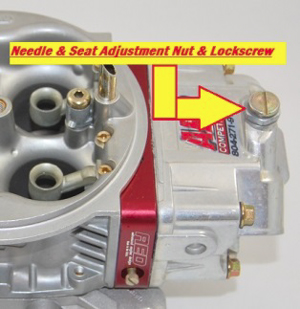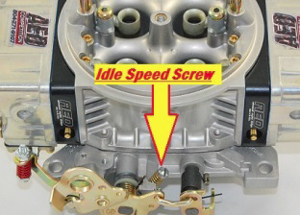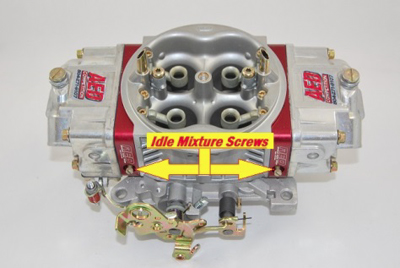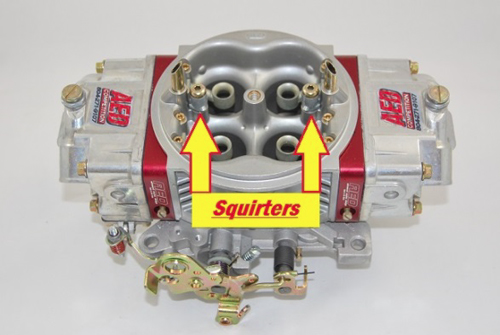 Start
the engine and check float level adjustment –
The level should be ½ - ¾ of the way up
in the sight window. The level can be adjusted with
the nut & lockscrew on top of each bowl. If you
want to raise the level, gently loosen the nut about
a ½ turn and re-tighten the lockscrew. Re-check
the level and repeat as needed. If you want to lower
the level, you will need to loosen the nut slightly
to break the lockscrew loose, then tighten the nut a
½ turn and re-tighten the lockscrew and repeat
as needed. Be sure you hold the lockscrew still as you
tighten the nut to ensure the float height will change
accordingly.
Start
the engine and check float level adjustment –
The level should be ½ - ¾ of the way up
in the sight window. The level can be adjusted with
the nut & lockscrew on top of each bowl. If you
want to raise the level, gently loosen the nut about
a ½ turn and re-tighten the lockscrew. Re-check
the level and repeat as needed. If you want to lower
the level, you will need to loosen the nut slightly
to break the lockscrew loose, then tighten the nut a
½ turn and re-tighten the lockscrew and repeat
as needed. Be sure you hold the lockscrew still as you
tighten the nut to ensure the float height will change
accordingly.
 Check
the engine’s idle speed. If you want to raise
the idle speed, simply tighten the primary idle speed
screw. To lower the idle speed, loosen the idle speed
screw.
Check
the engine’s idle speed. If you want to raise
the idle speed, simply tighten the primary idle speed
screw. To lower the idle speed, loosen the idle speed
screw.
 The
idle mixture screws will be the next adjustment to check.
These 4 screws control the amount of fuel given to the
engine @ idle. The easiest way to remember how these
work is to think of them as a water faucet/spigot on
the side of you house. The more you loosen the handle,
the faster the water comes out. On the other hand, the
more the handle is tightened, you turn the water off.
These mixture screws function in exactly the same fashion.
The most important thing is to be sure what ever changes
you make to 1 corner of the carburetor, the other 3
will need to follow suit. This will ensure equal distribution
and help eliminate drivability issues as well.
The
idle mixture screws will be the next adjustment to check.
These 4 screws control the amount of fuel given to the
engine @ idle. The easiest way to remember how these
work is to think of them as a water faucet/spigot on
the side of you house. The more you loosen the handle,
the faster the water comes out. On the other hand, the
more the handle is tightened, you turn the water off.
These mixture screws function in exactly the same fashion.
The most important thing is to be sure what ever changes
you make to 1 corner of the carburetor, the other 3
will need to follow suit. This will ensure equal distribution
and help eliminate drivability issues as well.
To
richen the idle, loosen all 4 screws equally about ¼
- ½ turn each. Re-check idle quality and repeat
as needed.
If
the idle is too rich initially, you will need to lean
the idle by tightening the 4 screws equally about ¼
- ½ turn each. Re-check idle quality and repeat
as needed. Be careful not to overtighten the idle mixture
screws as this can damage the needle tip. It is perfectly
normal for idle speed to vary as you change the idle
mixture screw adjustment. If idle speed varies greatly
from the desired idle speed while making adjustments,
adjust primary idle screw as needed after setting all
4 screws equally.
 The
accelerator pump nozzles or “squirters”
are sized according to the size of the carburetor. Different
intake and cylinder head combinations may require more
or less pump shot. If the engine seems to have an off-idle
stumble, changing the size of the squirter itself can
fix this issue.
The
accelerator pump nozzles or “squirters”
are sized according to the size of the carburetor. Different
intake and cylinder head combinations may require more
or less pump shot. If the engine seems to have an off-idle
stumble, changing the size of the squirter itself can
fix this issue.
The
first thing to do is determine whether it’s a
lean or a rich stumble. If the engine seems to take
a deep breath and then accelerate quickly (almost like
the ignition cuts off for a split second), it’s
generally a lean stumble. Check the size of the squirter
on the primary side and install the next largest size.
If that seems to help, but not completely eliminate
it, try increasing the size of the secondary squirter.
If
the engine seems to have a “blubber” or
is lazy to accelerate then cleans up as it builds RPM,
it’s generally a rich stumble. Check the size
of the squirter on the primary side and install the
next smallest size. If that seems to help, but not completely
eliminate it try decreasing the size of the secondary
squirter.

